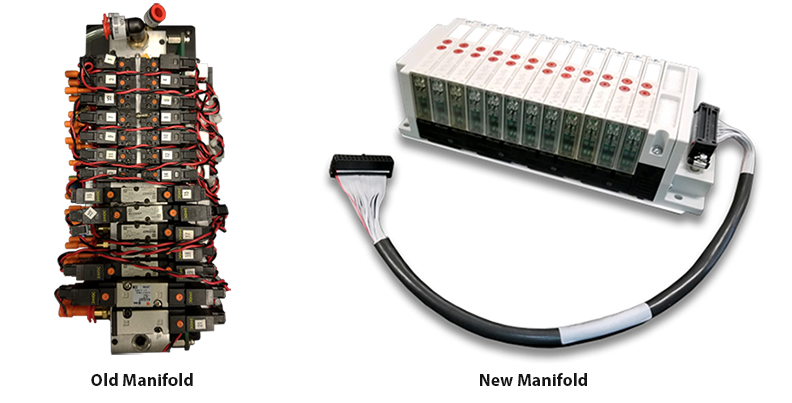In the semiconductor industry, keeping equipment in top shape is a chief priority. To ensure that every batch of wafers coming out of the process meets the meticulous industry standards for quality, every component in the process must be regularly maintained. One piece of equipment in particular has proven to have an inevitable operational shelf life: the EV manifold. It's only a matter of time before something stops working.
Process engineers must be aware of this phenomenon happening in the industry because once it becomes the process engineer’s problem, it is already too late. The equipment engineer typically oversees an entire fleet of equipment, often more than 40 tools on the floor. However, because process engineers are more involved in the process, it is typically incumbent upon them to find a way to maximize production and avoid costly scrap and equipment downtime.
In the semiconductor market, EV manifolds are typically found in 150-, 200- and 300-mm tools. Any new semiconductor fabrication plant is going to be built utilizing a 300 mm tool. However, semiconductor fabrication plants that have been in operation for an extended period of time still typically house a 150- or 200-mm tool that uses Pneumatic or EV manifolds.
Because of how these EV manifolds were designed, it's more difficult to maintain them. Additionally, because these EV Manifolds are no longer being produced, one is less likely to be able to find suitable replacement parts from the OEM (if they are still in business). Adding even more complexity to the challenge, the expense associated with a new tool is significant. Buying a new tool for the process can often be cost prohibitive for a plant and not a capital expenditure they are prepared to make.
AC-150-2444 Gas Box Manifold vs, Legacy Manifold

Unfortunately, all manifolds inside the aging 150- and 200-mm tools will eventually fail. The most common factors that can cause a manifold to fail are manifold total usage age, older design, lower EV cycles, low flow and pressure derived from the manifold. A catastrophic event could very easily destroy all the wafers in the process. If a process valve is not being closed properly, it could release unneeded gas into the process recipe.
That valve did not close because a valve on the EV manifold failed. This kind of failure is not typically noticed until an entire wafer batch is completed, which means consequently that the entire batch must be scrapped. This can be a very expensive lesson to learn the hard way.
Process engineers don’t know when a valve will fail, and most fabs do not have preventative maintenance plans for these EV manifolds. They could be one recipe away from a catastrophic event. The key is to fix this eventuality before it comes to fruition. As a process engineer, it is your responsibility to keep the process moving along in the most productive, optimized manner possible. The day that batch of wafers comes through the process that needs to be completely scrapped because the manifold failed is a costly experience to say the least.
So, what can be done to fix the problem?
The first is to step is recognizing the issue before you see a sign that there is a problem that needs fixing. This usually involves working with the equipment engineer to proactively find the solution before it becomes a far more expensive problem. How do you know if your EV Manifold is going to be a problem? If the EV Manifold is inside of a 150- or 200-mm tool, it is going to be a problem. It is that simple.
Fortunately, if a semiconductor fab does in fact have 150- or 200-mm tools, there is a way to retrofit them so that this is no longer a ticking time bomb. There are drop-in pneumatic EV manifold replacements for these progressively more outdated semiconductor tools being used in fabs today.
The main issue aging EV manifolds face is valve failure. These kits are brand-new non-refurbished replacements for the manifolds in question that were installed over 20 years ago and could be obsoleted. By getting in front of this issue and installing a plug-and-play solution to retrofit these tools, process engineers can eliminate the valve failure issue before experiencing the horror of entire wafer batches coming out defective.
Another benefit of upgrading an aging manifold is the size of the valves’ flow that comes with the investment. There is an improved response time that comes with this larger flow.
The best news about the solution is that fabrication is not required with these plug-in-play kits. They can efficiently be installed by house personnel through detailed, step by step instructions, keeping the headaches to a minimum. In fact, the installation should take less than 45 minutes. The fit, form and function all remains the same and there is no loss of gaskets and screw.
Many process engineers are unaware that 1) this is a real issue in the industry that sooner or later will be placed at their feet and that 2) there is a cost-efficient solution that does not involve investing in a new tool.
Before this becomes an issue that falls squarely on the shoulders of the process engineer, it makes sound economic sense to address it immediately.
Article featured on Automation.com